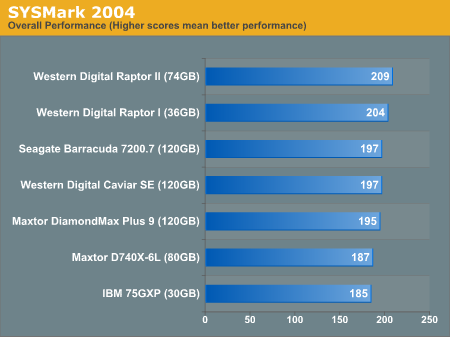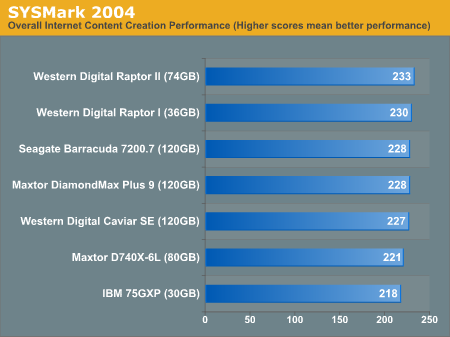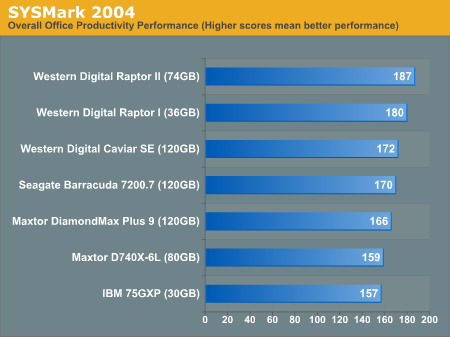Q2 2004 Desktop Hard Drive Comparison: WD Raptor vs the World
by Anand Lal Shimpi on June 7, 2004 12:05 AM EST- Posted in
- Storage
SYSMark Performance Summary
The overall SYSMark scores summarize what we've seen thus far:

As a recap, here's what happens with the Internet Content Creation suite:
"In this scenario, the content creator creates a product-related website targeting a broadband and narrowband audience. The user first renders a 3D model to a bitmap, while preparing web pages using a web site publishing tool. The user opens a video editing package, creates a movie from several raw input movie cuts and sound cuts and starts exporting it. While waiting on this operation, the user imports the rendered image into an image-processing package, modifies it and saves the results. Back in the 3D modeling software, the user modifies a 3D model and exports it to a vector-graphics format. Once the movie is assembled, the user edits it and creates special effects using one of the modified images as input. The user extracts content from an archive. Meanwhile, he uses an animation creation tool to open the exported 3D vector graphics file. He modifies it by including other pictures and optimizes it for faster animation. The final movie with the special effects is then compressed in a format that can be broadcast over broadband Internet. The web site is given the final touches and the system is scanned for viruses."

In the Internet Content Creation tests, we see that although there is a difference in performance between current and previous generation hard drives, there's very little that separates the 10,000RPM Raptors from the 7200RPM drives.
Also recapping, here's what happens in the entire Office Productivity suite:
"In this scenario, the office productivity user creates a marketing presentation and supporting documents for a new product. The user receives email containing a collection of documents in a compressed file. The user reviews his email and updates his calendar while a virus checking software scans the system. The corporate web site is viewed and the user begins creating the collateral documents. The user also accesses a database and runs some queries. A collection of documents are compressed. The queries' results are imported into a spreadsheet and used to generate graphical charts. The user then transcribes a document. Once the document has all the necessary pieces in place, the user changes it into a portable format for easy and secure distribution. The user edits and adds elements to a slide show template. Finally, the user looks at the results of his work (both the slide show and the portable document) in an Internet browser. "

Office Productivity paints a much different picture, with significant advantages being seen over older drives. The Office Productivity suite also paints a much more compelling picture of the Raptors' performance; even the older Raptor manages to maintain a decent performance advantage over the cream of the crop 7200RPM 8MB Parallel ATA drives.
Overall performance is an average of the two suites, and thus, we see that a lot of the impressive performance gains in Office Productivity are diluted by the relatively little variation in Internet Content Creation performance.










50 Comments
View All Comments
Athlonite - Saturday, March 24, 2007 - link
both raptor drives are SATA and all the other drives are Pata i know for a fact the seagate baracuda 7200.7 comes in a sata II form coz i have two of them in raid 0 i'd pit the against your single raptor any day of the week as i said like comaring apples with peaspeufeu - Monday, May 9, 2005 - link
Stop benchmarking copies of 1 MB files !Linux, with reiserfs4 :
My crap laptop harddrive does about 16 MB/second raw bandwidth. It does 15 MB/second reading 20 KBytes files. Not that bad.
I'd like to see the raptor benchmarked with reiser4. I'm pretty sure it can sustain at least 80% of its peak bandwidth with 1kbyte files...
jferdina - Sunday, August 22, 2004 - link
here is a link:http://www.buildsilentpc.com/forum/viewtopic.php?t...
jferdina - Sunday, August 22, 2004 - link
I want to WARN you all of Seagate Barracuda 7200.7I just bought one for 1 day and I am terribly disappointed.
Unlike the seagate barracuda 7200.7 that was tested by AnandTech, the newer version is EXTREMELY noisy. It is the most noisiest HD that I have ever had.
The reason is Seagate got into a lawsuit problem with Convolve. Apparently Seagate steals their technology, and at least for now they have to remove it. The technology is 'Automatic Acoustic Management' (AAM).
But for those of you who are tricked, like me, there is some information that may give a hope, AAM is still there but they set it in "performance" mode by default on current firmware. But hardware.fr claimed they had firmware 3.16 and could change the setting.
So MAYBE IF they can settle the lawsuit, Seagate would provide firmware upgrade to solve this problem.
Anandtech, please change your review about Seagate since the information is already old because it is very frustrating for customers that wishes to find an accurate info, gets the completely opposite result from what informed.
Fietsventje - Wednesday, June 16, 2004 - link
I didn't read all of the comments, but I would like to say that I, like some others here, would like to see what impact a RAID0-array has on these benchmarks. Could finally resolve the ever-lasting discussion (at least, for myself) about the influence of a RAID-0-setup to general performance.Greetz,
Fietsventje
skyce - Monday, June 14, 2004 - link
I would really like to see a comparison of one 74GB SATA Raptor 10k to two new Raptors in Raid0. I'm building a system over the next couple months and would like to have this drive in my system, but am somewhat reluctant to fork over another $200 for a second drive for Raid0, as Wesley suggested in his High End System Guide (May 26th).HelzBelz - Monday, June 14, 2004 - link
... and also, it just so happens that I've just received the exact same hardware (see previous post), but for 2 different systems (upgrades for other people).
i.e. 2x 80GB ATA WD 8Meg w/ Highpoint 370 PCI RAID Card, and one 74GB SATA Raptor 10k...
Perhaps we could then compare results !?
Regards,
HelzBelz
HelzBelz - Monday, June 14, 2004 - link
Perhaps this has already been suggested, but here it goes:
- What about a RAID0 test of some pair of less expensive drives VS a Single Raptor ?
i.e. For "about the same money", I've often been asked: "Which of the abobe is better / faster ?"
For example, one could compare the performance of a "2x WD 80GB 8MB cache RAID0" setup, versus a Single 74GB Raptor 10k drive; since either way, you're paying about the same total price...
Just a thought,
HelzBelz
artifex - Sunday, June 13, 2004 - link
I'd like to get a MTBF comparison, not just some data on warranties, too. Or better yet, it would be cool for Anandtech to actually set up a system to run the test drives continuously until they start failing.Why? Our local Fry's often has drives like the PATA version of a Hitachi 200GB on sale for $50 after rebates, but if they burn up or crash in half the time as a $100 drive, I'd much rather get the $100 drive. This is particularly important for applications like adding drives to PVRs, where it's not easy to remap around known bad sectors after they're found, and at least one manufacturer's low level formatting utility won't work with Nforce-based IDE, so remapping at the lower level is out also.
I'm also hoping for thermal comparisons; in small form factor enclosures this is just as important as noise.
MadAd - Saturday, June 12, 2004 - link
IMO you are missing a very important 'real world' test that has always interested me on machines through years.Test: Tester starts stopwatch as power button us pressed. Tester stops stopwatch at the point that the desktop appears ready for use...... Record Time Taken. Thats it!
The funny thing is youve probably not realised how much you run this 'test' and its a valid one insofar as everyone needs to boot up at some point - just please, do us a favor, time it and chart it? :)
Thanks